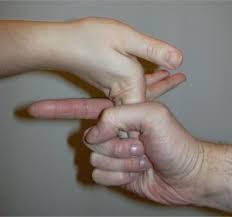Finger locks go way back. They’re also called small manipulation techniques mainly used on fingers, toes, and wrists. Since I’m a Hapkidoist, I’ll tell you a bit about its history before showing you today’s video.
Hapkido is the combination of two Korean Martial Arts – Yool Sool which comes from the Japanese art known as Daito-Ryu Aiki-Jutsu and Tae Kyon which is an ancient Korean Kicking Skill that was widespread during the time of the Three Kingdoms. – International Modern Hapkido Federation
Today, there is no one system of Hapkido, as is the case with WTF Taekwondo, for example. As time has gone on, each teacher and ensuing organization has integrated their own understandings and self defense realizations into this art. There are, however, two distinct types of Hapkido. The first are the schools which hold tightly to the original teachings of Yong Shul Choi. This style of Hapkido will commonly be observed when visiting or studying in the Hapkido dojangs located in the Taegue vicinity of South Korea. Here, the focus is placed primarily upon the Daito Ryu based joint locks, deflections, and throws. The second distinct style of Hapkido is those instructors, schools, and organizations who trace their lineage to Grandmaster Ji, Han Jae – whether directly or indirectly. In these schools one will observe a plethora of punching, kicking, and weapon techniques, in association with the joint locks and throws commonly associated with Hapkido. This style of Hapkido will commonly be observed at the dojangs based in Seoul, South Korea and, in fact, most of the Western world. – Scott Shaw
You might recall that one night I used a finger lock, on a guy named Rick, while at Katrina’s club. He’d made the mistake of following me, and then putting his uninvited hand on my shoulder as I walked away. I didn’t need to break anything. Well, I suppose his ego might have taken a blow, but I’m good with that.
I encourage you to learn a few small joint manipulation techniques. They’re easy and practical. Here’s a technique that never gets old. It’s a basic finger lock. Don’t let this guy fool you; It didn’t originate with Krav Maga. Krav Maga borrowed much of its techniques from more established martial art forms, including Hapkido.
You might wonder if this really works. I mean, why doesn’t the attacker just hit you with the other hand? Practice finger locks a few times, and you’ll understand just how difficult it is to a) get out of one, and b) how much it hurts. Your attacker’s brain is focused on the pain and you’re in control of that. In this specific example, if he tries to stand up, the guy simply applies a little more pressure on that finger. Now, you do need to be ready to use other techniques so you can heel-toe express your way out of the situation.
Be careful and intentional when you practice small joint manipulation. Go too fast, and you’ll break your partner’s joint. The point of practicing is for you to understand 1) the movement required to inflict pain, and thus control your partner, and 2) how small, precise movements can harm even the largest person.
Lock, rock, and roll.
Note: As with every technique I post, 1) you need to practice with a willing adult participant, 2) I don’t endorse any of the sites or teachers, and 3) you need to be aware of and know the self-defense laws in your state. The purpose of these posts is to provide you with information about techniques I would use in certain situations. If you really want to become an expert in self-defense, then you need to find a dojang or dojo. If you have questions about how to identify a good dojang or dojo, post your questions in the comments.


